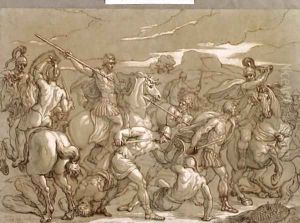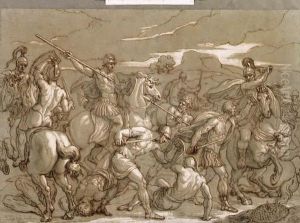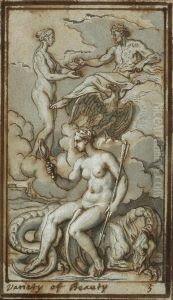Charles-Louis Chron Paintings
Charles-Louis Clérisseau was a pivotal figure in the neoclassical movement, an architect, and an artist renowned for his influential role in European art and architecture during the late 18th and early 19th centuries. Born in Paris, France, in 1777, Clérisseau's career was a bridge between the classical traditions of ancient Rome and the emerging neoclassical style that sought to revive and reinterpret these ideals. His death in 1855 marked the end of a career that had a lasting impact on the architectural and artistic trends of his time.
Clérisseau's education in art and architecture was comprehensive, initially studying under the guidance of key figures at the French Academy in Rome. It was here that he developed a profound appreciation for ancient architecture, which would become a hallmark of his work. His travels in Italy, particularly his studies and sketches of ancient ruins, significantly influenced his aesthetic direction. He was among the first to document the ruins of ancient Rome with a romantic sensibility, blending meticulous architectural studies with atmospheric landscapes. This approach not only made him a sought-after artist but also a respected advisor to architects and designers seeking to incorporate classical elements into their work.
Throughout his career, Clérisseau formed significant relationships with prominent figures of his time, including serving as a mentor to Thomas Jefferson during the latter's time in France. His influence is credited with inspiring Jefferson's neoclassical vision for much of the architecture in Washington, D.C., including the design for the Virginia State Capitol. Clérisseau's work extended beyond mentorship and individual contributions to architectural projects; he was also a prolific author. His publications, most notably 'Antiquités de la France,' were instrumental in spreading neoclassical ideas throughout Europe. These works provided a rich source of inspiration for architects and designers by offering detailed engravings and descriptions of classical architecture.
Despite his considerable influence, Clérisseau remained a somewhat enigmatic figure, often overshadowed by his contemporaries and the architects he inspired. Yet, his legacy is unmistakable in the spread of neoclassical architecture and the continued appreciation for classical antiquity in modern design. His contributions to architectural theory, his role in the education of future architects, and his artistic output have cemented his place in art history. Charles-Louis Clérisseau's death in 1855 was the end of an era, but his vision and influence lived on, echoing through the corridors of neoclassical buildings and the pages of architectural history books.


